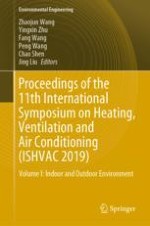2020 | Book
Proceedings of the 11th International Symposium on Heating, Ventilation and Air Conditioning (ISHVAC 2019)
Volume I: Indoor and Outdoor Environment
Editors: Prof. Zhaojun Wang, Prof. Yingxin Zhu, Prof. Fang Wang, Prof. Peng Wang, Prof. Chao Shen, Prof. Jing Liu
Publisher: Springer Singapore
Book Series : Environmental Science and Engineering
